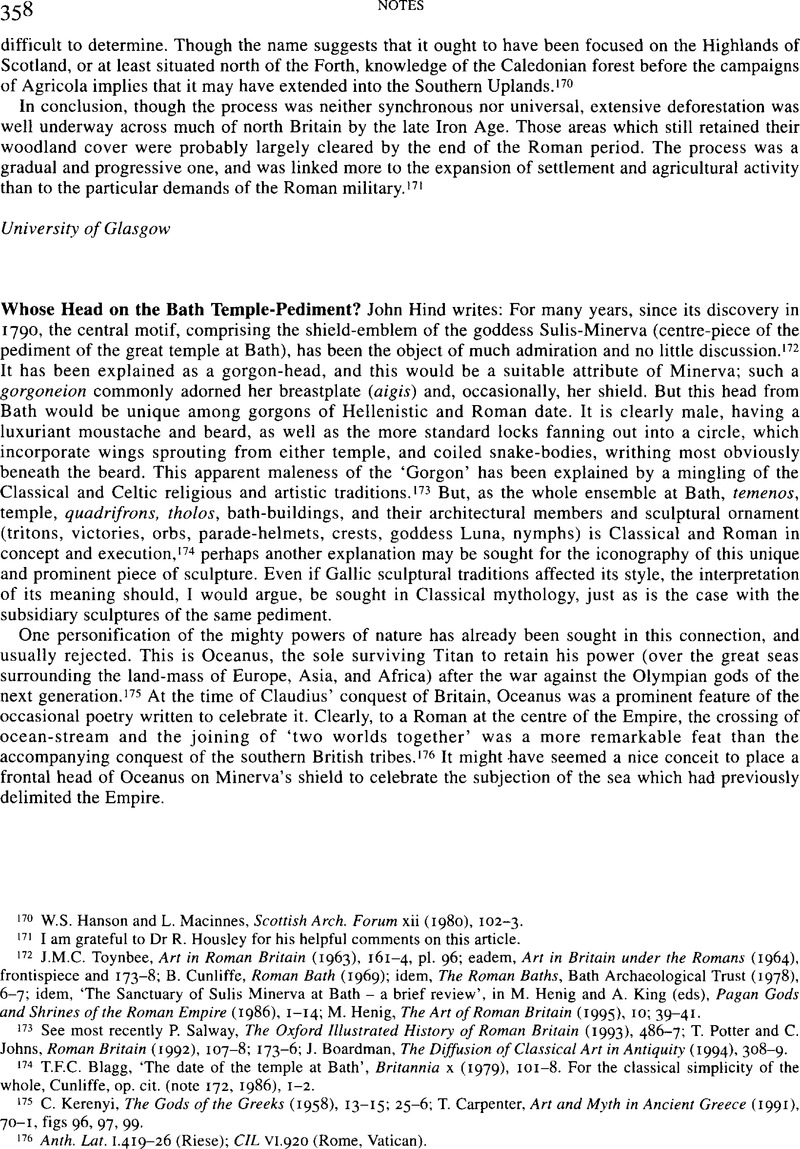Article contents
Whose Head on the Bath Temple-Pediment?
Published online by Cambridge University Press: 09 November 2011
Abstract

- Type
- Notes
- Information
- Copyright
- Copyright © John Hind 1996. Exclusive Licence to Publish: The Society for the Promotion of Roman Studies
References
172 J.M.C. Toynbee, Art in Roman Britain (1963), 161–4, pl. 96; eadem, Art in Britain under the Romans (1964), frontispiece and 173–8; B. Cunliffe, Roman Bath (1969); idem, The Roman Baths, Bath Archaeological Trust (1978), 6–7; idem, 'The Sanctuary of Sulis Minerva at Bath – a brief review’, in M. Henig and A. King (eds), Pagan Gods and Shrines of the Roman Empire (1986), 1–14; M. Henig, The Art of Roman Britain (1995), 10; 39–41.
173 See most recently P. Salway, The Oxford Illustrated History of Roman Britain (1993), 486–7; T. Potter and C. Johns, Roman Britain (1992), 107–8; 173–6; J. Boardman, The Diffusion of Classical Art in Antiquity (1994), 308–9.
174 Blagg, T.F.C., ‘The date of the temple at Bath’, Britannia x (1979), 101–8CrossRefGoogle Scholar. For the classical simplicity of the whole, Cunliffe, op. cit. (note 172, 1986), 1–2.
175 C. Kerenyi, The Gods of the Greeks (1958), 13–15; 25–6; T. Carpenter, Art and Myth in Ancient Greece (1991), 70–1, figs 96, 97, 99.
176 Anth. Lat. 1.419–26 (Riese); CIL VI.920 (Rome, Vatican).
177 Most recently in J. Boardman (ed.), The Oxford Dictionary of Classical Art (1993), 354, fig. 363. For the silver dish from Mildenhall, K. Painter, The Mildenhall Treasure (1977); Toynbee, op. cit. (note 172, 1963), 169–71, pl. 117.
178 For Oceanus representations see A. Rainey, Mosaics in Roman Britain (1973), cover illus.; M. Rule, Floor Mosaics in Britain Fishbourne and Other Sites (1974), 33; R. Brilliant, Roman Art from the Republic to Constantine (1974), 139. For ‘sea-medusas’ and male Medusas on bronzes, and as stone reliefs, see Toynbee, op. cit. (note 172, 1963), 175, pl. 134; 158–9 pl. 91 and pl. 248.
179 e.g. Journ. Glass Stud, xxxii (1990), figs 92, 94, 116–17Google Scholar, figs 3–4.
180 Kerenyi, op. cit. (note 175), 26.
181 Winnefeld, H., Die Friese des Grossen Altars – Altertümer von Pergamon III.2. (1910)Google Scholar; G.D. Byelov, Altar Zevsa v Pergamye (1958).
182 Kerenyi, op. cit. (note 175), 22–4; fig. on p. 23.
183 For Typhoeus as the subdued monster spouting forth volcanic eruptions in Sicily and Campania, see Pindar, Pyth. 1.16–28; 8.16–18. According to Strabo (V.4.9.) Typhoeus was responsible for the hissing hot springs on Ischia, D. Ridgway, The First Western Greeks (1992), 31–5.
184 The gigantomachy theme was one of the most frequently treated in Greek architectural sculpture – on the pediments at Corcyra, at Delphi, on the pre-Parthenon temple at Athens, and on temple friezes on the island of Siphnos and on the Parthenon itself, M. Robertson, A Shorter History of Greek Art (1981), 229; J. Boardman and D. Finn, The Parthenon and its Sculptures (1985), 246.
185 ‘The more we study the Bath Medusa, Celtic as it is, the more are we aware of its largely Classical ancestry, the more intellectually controlled and civilised, the less barbaric, does it appear’, Toynbee, op. cit (note 172, 1963), 163. I would delete the phrase, ‘Celtic as it is’.
- 3
- Cited by


